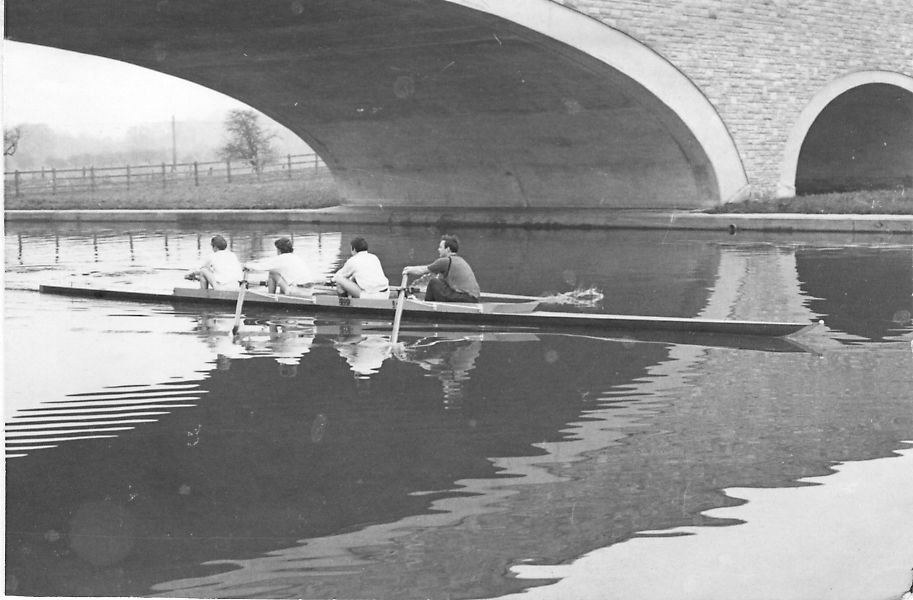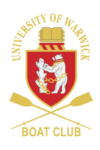history
Thanks to Godfrey Bishop for a very informative account of UWBC’s foundation.

Godfrey Bishop & Dave Hitt with the first UWBC Boats & ‘boathouse’ (1967-68)
Earliest Activity
As far as I know there was no rowing activity amongst the first (1964) intake of graduate students to the University of Warwick. 1965 saw the first batch of undergraduates and among these were three or four who started rowing informally at Stratford Rowing Club. Of those, one had rowed previously at Ealing G.S. and another had coxed at Tonbridge but there was no move amongst the first undergraduate intake to found a proper University Boat Club or to engage in competitive rowing.
1966-67
A number of us who entered as undergraduates in October 1966 had previous competitive rowing experience. I had been captain of Kingston Grammar School Boat Club, rowing in the P.E. at Henley and for Kingston R.C. ; John Fawthrop had rowed at Tiffin School and subsequently for Kingston R.C. and Andy Hughes-Hallett had rowed at Radley. There were also a number of other undergraduates (John English, Dave Hitt et al) who were interested in taking up the sport.
We began by joining the previous year’s rowers in driving down to Stratford R.C. to go out there (in 1966 this involved long delays driving via Leek Wootton and through the centre of Warwick as the by-pass had not yet been opened). From the outset, it was clear that some of the ‘old guard’ at Stratford R.C. resented this intrusion of undergraduates although there were some members who were interested in our beginnings and who gave both help and advice. One of these was Chris Morgan, a sixth former at Kenilworth G.S. and another was Henry Hatton (also a member of Leander) who later coached us on a number of occasions. There was no invitation to combine forces with Stratford R.C. However, John Fawthrop and I did ‘represent’ the university at Evesham and Hereford regattas rowing in ‘Coxed Open Pairs’ in a borrowed Stratford clinker boat. Not surprisingly, we brought up the rear (hopefully without too much discredit to later crews) at both these events!
By the summer of 1967, John and I felt that being based at Stratford was not going to lay the foundation for a successful University Boat Club. Apart from the political issues, the stretch below Clopton bridge was far too short and comprised one large bend above the weir. By this time, the large huts, which had been used on the East Site by the contractors during the first phase of building, were standing empty and I realised that since they were just over sixty feet in length they had boathouse potential to rack IVs and even VIIIs. We discovered that one of the Assistant Registrars, Hugh Patterson had an interest in rowing and so we approached him to see whether one of the redundant sheds shed might be appropriated to start a University Boat Club. Initial meetings were encouraging but we lacked a site on which to place the potential boat shed.

1967-68
I am not sure at what stage it happened – probably in the summer term of ’67, but by the start of 1967-68 academic year John Fawthrop and I had become Treasurer and Captain respectively. The University Boat Club gained a seat on the Union’s sports committee and I also started the process of registering the Club with the ARA. We designed the first rowing kit as well as the red, black and white oarblade which I note is still in use.
The 1967 Freshers’ Conference saw the number of undergraduates topping 1,000 for the first time. We enrolled both experienced rowers and novices (no women in those days) though it was still unclear as to where we should row. We made forays to neighbouring university clubs (e.g. Leicester and Birmingham) by coach but no water seemed right – especially back at Stratford where the potential surge of varsity novices sent shock waves through the Stratford R.C. committee.
We desperately needed to find suitable water within easy reach of the campus. I began to look at the local Ordinance Survey map to examine the Avon between Stoneleigh and Stratford and then tried to ‘prospect’ for any stretch which offered hope by driving around and trying to find the river from the nearest road. Historically, the uppermost stretch of the Avon on which rowing had taken place was the one above Warwick weir. Warwick School had stopped rowing after a four had allegedly been swept over the weir with the loss of at least one life. Warwick Boat Club had a clubhouse above the weir but had long since ceased competitive rowing to focus on tennis (though they later restarted rowing – probably as a result of the birth of UWBC – and not without success). I decided to borrow a canoe and paddle down the river from above Leamington. My study of the map suggested a long stretch of reasonable width between Warwick Castle and Barford. Since this was before the M40 or even the precursor link road over the Avon between the Stratford end of the (by 1967 almost completed) Warwick by-pass and the Warwick to Banbury road it had proved impossible to reach the stretch on foot as all the riparian land was privately owned. Nearly forty-five years later, I remember my intake of breath, having portered my canoe around Warwick weir as I began to paddle downstream and saw what opened up before me on the water. First, I floated gently beneath the medieval walls of Warwick castle next into a widening reach and then on between densely wooded banks and under a stone footbridge on what I guessed to still be part of Lord Warwick’s estates. On and on the stretch seemed to go with portions wide enough for side by side racing practice. What a find! I could scarcely contain my excitement having found what I realised was the stretch of water we desperately needed. I could even see that there were possible sites on the lower reach for a boathouse. Wow!
We approached Hugh Patterson again to tell him that we had found the ideal stretch for the Boat Club. He did some research and we discovered that the riparian owner on the lower reaches nearer to Barford was Mr Smith-Ryland, Lord Lieutenant of Warwickshire and a supporter of youth sport at county level. Through Mr Bruce-Lockhart, University Development Officer we were able to set up a meeting with Mr Smith-Ryland who could not have been more helpful. We met him at his Estate office in Barford and he then drove us with his tenant farmer to show us a site below the proposed single arch road bridge about to be built across the Avon and we also agreed access across his farmland. The tenancy was set up with very generous river usage and at a peppercorn rent. Mr Smith-Ryland also persuaded Lord Warwick to allow us to row (other than in the duck shooting season!) on his water so the whole stretch was now at our disposal for rowing.
Encouraged by these developments and with the Club officially registered with the ARA, we set about acquiring equipment: oars from Kingston Rowing Club, two matched coxed clinker IVs from Wallingford RC and a new coxless IV from George Sims at Eel Pie Island, Twickenham. The first 4- comprised:
Bow & steers: Godfrey Bishop
2 John Fawthrop
3 Dave Brown (ex- Bedford Modern School)
Str: Diegan Morris (a graduate student, ex-Radley and brother of Sean Morris, President of OUBC)
Coach: Henry Hatton (Leander and Stratford RC)
This crew had little time to train properly but we raced at a number of Thames and other regattas with varying degrees of success. At least the Club’s colours began to make an appearance and there was encouragement from all sides.
Novice crews were formed and land training started at Woodlands School, Coventry (the University had no sports centre at this stage) and also weight-training on the top floor of the Rootes social building. Boats were kept under the flood arch of the new road bridge pending the erection of the new boathouse in 1968. Unfortunately, the Avon flooded in August 1968 and carried the two clinker IVs to a field above Barford weir. We realised as a consequence of this mishap that we’d need a raft which could cope with the rise and fall of the Avon and this was duly ordered and installed.
The Club was increasingly active socially and we built up a core of supporters. I spent ’68-’69 in France as part of my degree but I kept in close touch with developments which included the arrival of more experienced oarsmen (e.g. Eugene Deed and Don Trenear-Thomas). By December 1968 we were able to hold our first Boat Club Dinner at The Bear, Berkeswell which was a great success. I managed to acquire an VIII from Kingston RC which I believe was used for the first time in the Tideway HOR in 1970.
I married in my final year (’69 – ’70) at Warwick and so was less involved by that stage. John Fawthrop had graduated in 1969 but the seed we had planted was sprouting fast and it is so encouraging to note how successful the Club has become for men and women. The ‘temporary shed’ was clearly a good move – having lasted for well over forty years and the stretch obviously accommodates different levels of rowing without too much difficulty. At least one schoolboy I later coached (James Nickless at Monkton Combe) went on to row for the University and I hope that UWBC will soon achieve top success at Henley – a far cry from ‘Open Coxed Pairs’ at Evesham in a borrowed clinker boat!
